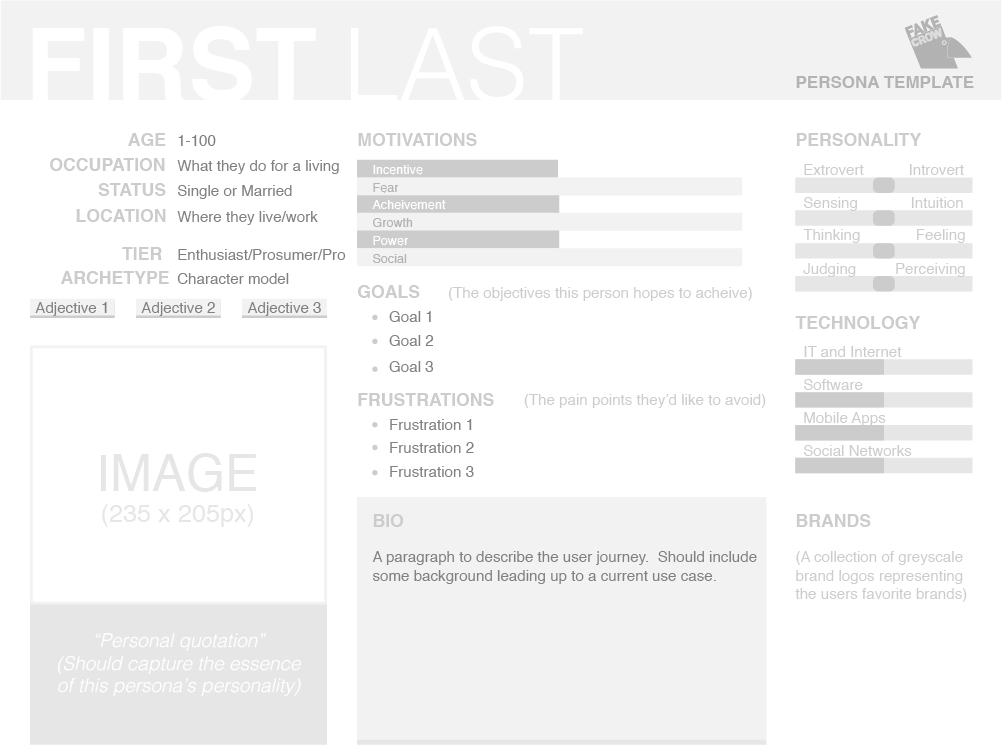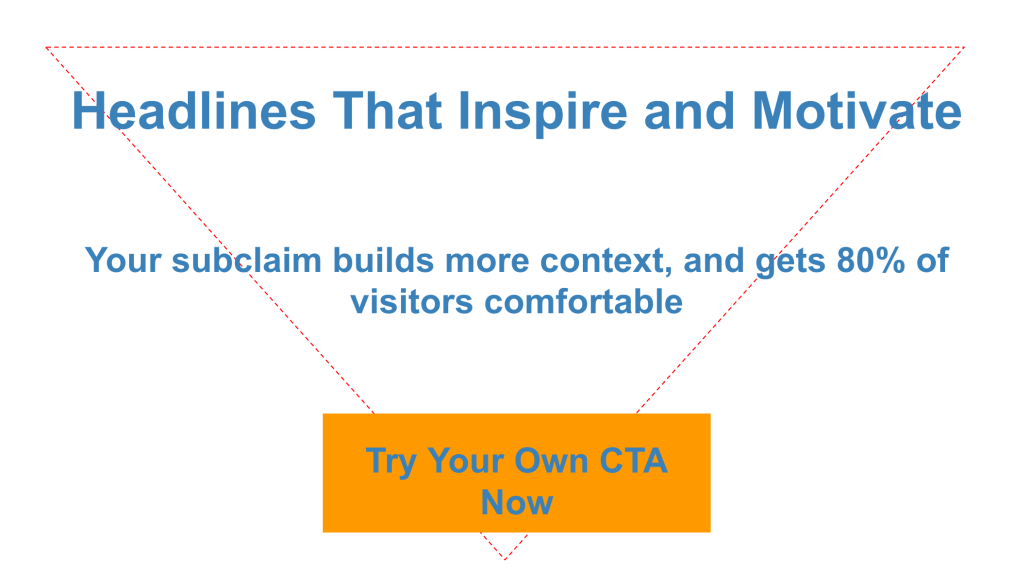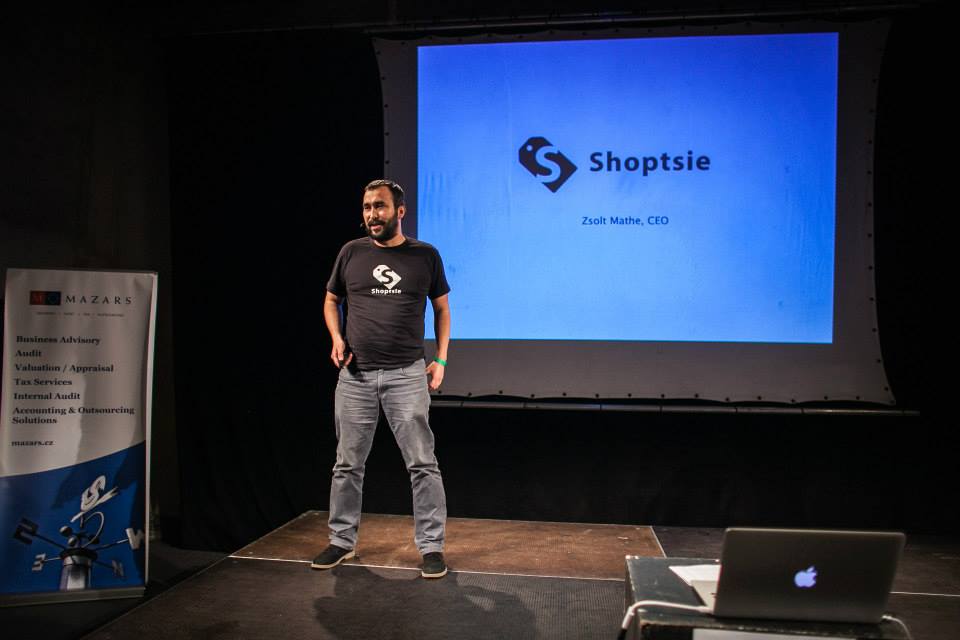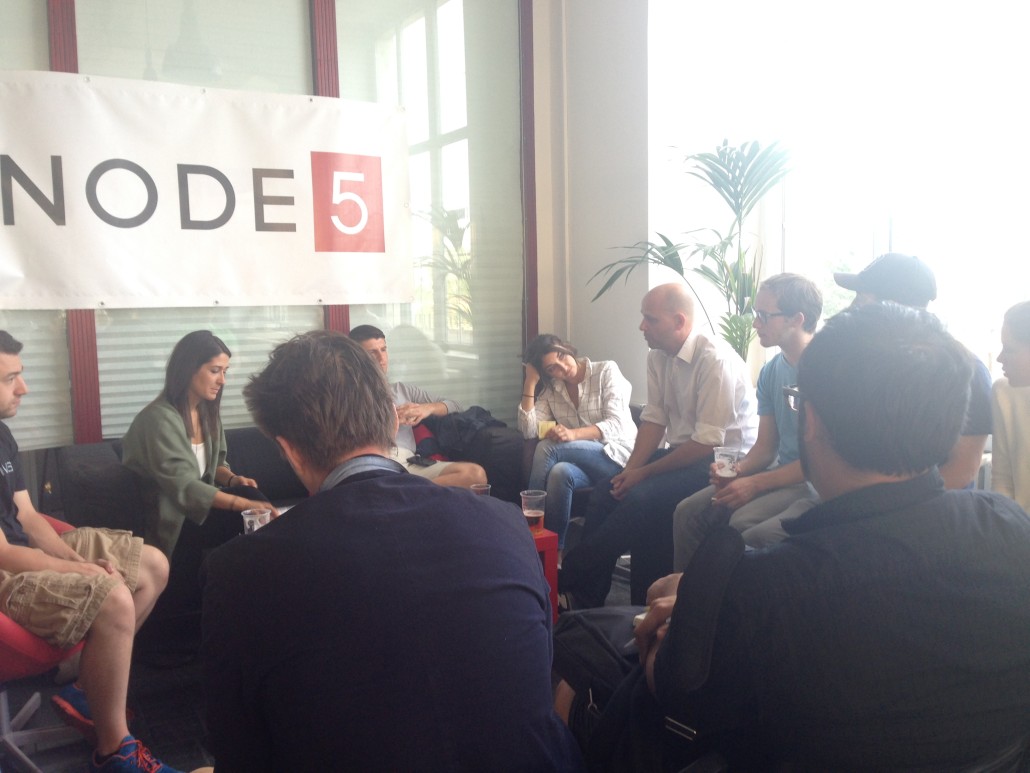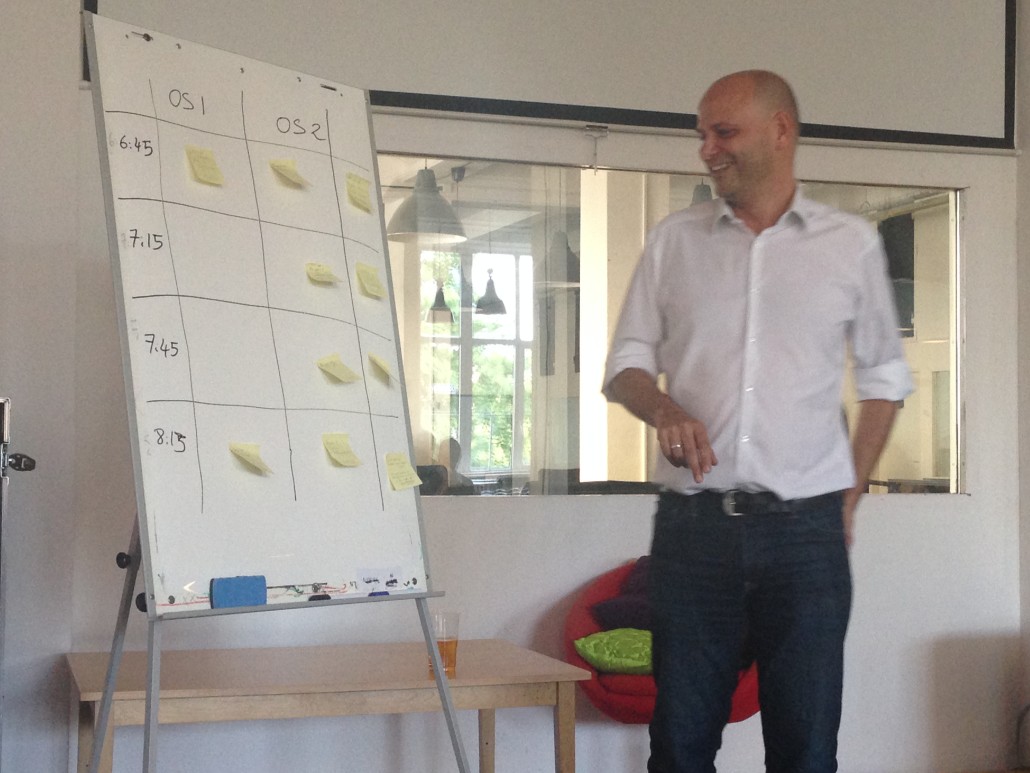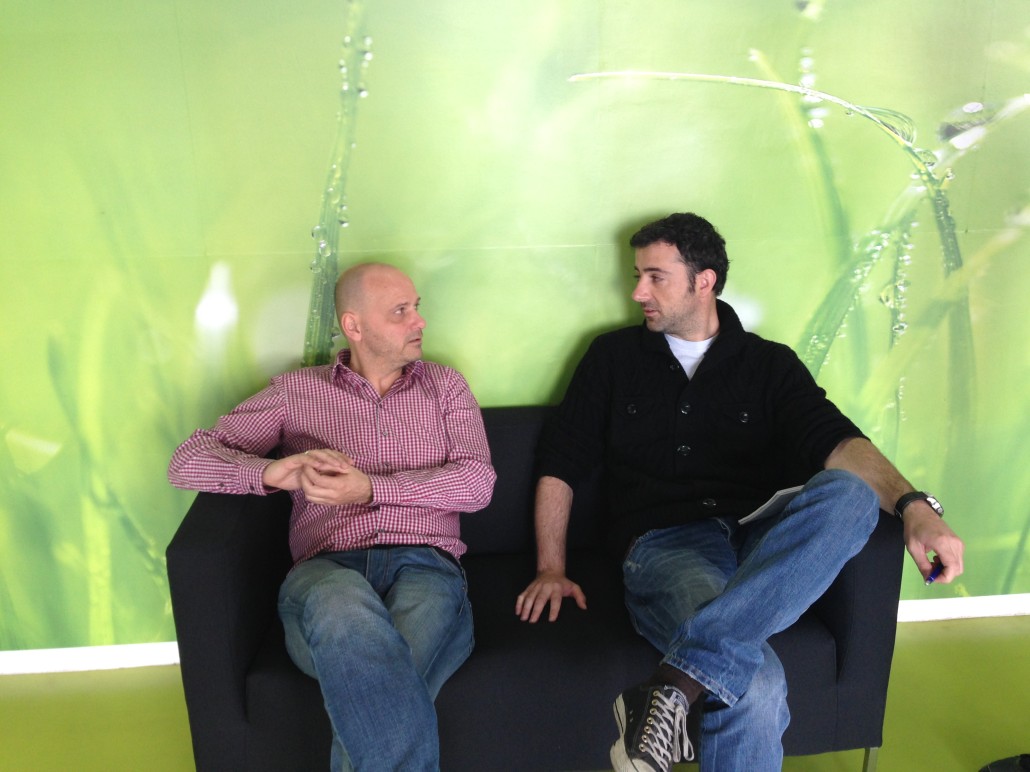User Persona: Getting Started
/in Marketing, Starting a Business, Startup Tools, Startups/by StartupYardA user persona can be a powerful analytical tool, if it’s done thoughtfully. But it’s something we regularly struggle to persuade startup founders to do with any enthusiasm.
That’s not surprising, really. Building a user persona can seem like voodoo, if you don’t appreciate the point of doing them. Or, it can feel like a kind of homework- something you have check off the list in order to get on with the really good stuff, which is building your product into something you can be proud of. But fear not- it’s neither voodoo nor homework. It can be fun, and more importantly, it’s extremely helpful in making you a better team, and a smarter company.
What is a User Persona?
Definitions vary, but here’s the one that I think is most useful for early-stage startups: a persona is essentially a description of your ideal customer. It includes general and detailed information about that user’s motivations, their goals, their situation in life, and the type of person they are.
Some user personas are written as a kind of narrative, including fanciful details to make the person feel more real. Others are utilitarian, like a government file or a social media profile.
While many templates and types of personas exist, the most important point is that they provide your team a target for their sales, marketing, UX, and design goals. Your user personas, particularly for startups, serve as a kind of ur-user; a face, name, and personality you keep in mind when you are working towards releasing a product.
Whatever format makes that most accessible and useful is ok to use, but we will also talk more about format later on.
What a User Persona is Based On
In a startup without any customers, or even without a finished product, it’s not always clear how to get started with a user persona. Who are your ideal customers? Since you don’t have any yet, it’s hard to say.
Should your personas be based on real people? Yes, and no. For a lot of startups, a “best guess” is necessary to get you started. This is often called a “proto-persona,” and it deals more with the basic needs and goals of a user, than with the specific ux expectations that user might have.
If you’re very familiar with the market segment you’re targeting, you can use that experience to construct a composite of the type of user who will buy or use your product. This is usually easier if the product is for professionals or a specific user-segment, because it will likely be based on some existing industry experience.
Say, for example, you’re building a Saas product for professional translators. You probably know a bit about that industry, and the types of people who need your solution. A composite of people you already know can serve as a jumping off point for your user-persona.
Again, the idea is to composite an “ideal” candidate user. This is the person who will be your best customer, and will gladly buy from you. They are the perfect fit for your product. Though most customers won’t fit that mold exactly, a persona should help you steer your efforts towards the people who will want to use (and pay to use) your product most.
You can also find relatively cheap ways of doing market research, such as conducting broad social media campaigns, or a survey, and analyzing the users who fill out the survey, or convert on your landing pages, or who like the posts on your Facebook page.
You are Not your User
These educated guesses can give you an overall view of who is responding most to your product, but keep in mind, the composition of that group will be dependent on the communication of the campaign as well.
Many startups start out thinking that their typical users are basically analogues of themselves. This is most common in startups where the founders might actually be very similar to their eventual customers, because the startup is based on a specific hobby, or interest. It can lead you to many false conclusions about who your ideal customer really is. Many male startup founders, for example, undervalue the appeal of their products to women, and so ignore evidence that women are interested in their products.
Jakob Nielsen, the influential usability expert, puts it this way in Growing A Business Website:
“One of usability’s most hard-earned lessons is that ‘you are not the user.’ If you work on a development project, you’re atypical by definition. Design to optimize the user experience for outsiders, not insiders.”
The lesson extends beyond usability, to marketing, feature design, and many other areas. A very compelling reason for building a user persona is to challenge your assumptions against future evidence, including user testing and user feedback.
If you find, after some period of time, that your user persona isn’t lining up very well with the reality of your sales results, then it might be time to adjust the persona. You may find that the early adopters from that unexpected segment reveal an untapped demand among users like them, who are not early adopters.
If you don’t have a user persona to work with, then you don’t have anything to challenge your assumptions with. New user behavior is just noise without clear context. Why are certain types of users attracted to your product? How can you get more of those types of users? It will be difficult to figure out where to start.
Enjoying our blog? You can help StartupYard grow by tweeting our posts.
What a User Persona Looks Like
You’ll find many examples of user personas online, and many twists on the basic pattern. You don’t have to stick with any one of those. There are no rules. But your format should compliment your goals in creating a persona. What will this persona help you to do? Will it be used to shape your marketing message? Will it dictate what features you plan? Will it influence the design?
Hopefully, you have a range of goals you need to accomplish, and the user persona is a kind of benchmark. You can refer back to him or her (they can have a name and everything), and ask yourself and your team: “Is John really interested in this feature?” or “will Jackie really respond to that kind of email?” In time, you can add real observations of your users to flesh out this fictional person. Your team can become familiar with them and their issues and goals.
A format I really like, for its clarity and ease of use, is this one, from fakecrow.com (a service for creating user personas):
The persona is laid out less like a story than a file on an existing person. The kind of thing you might see in a spy movie. It also allows you and your team to see a big picture representation of a person from many angles: what they do for work, what their personal life is like, what kind of technology they use, and what kind of personality they have. Each data point can be a discussion topic, and a test of your own thinking about the product.
Most startups should challenge them to create at least 3 different personas, and test them in the real world, either through marketing, or in person testing of people who match the profile as closely as possible.
Keep in mind, your goal at the beginning is not to find out what is most typical or most common, but which type of user is ideal for you. Usually, that’s the person most ready and able to buy your product. This early testing of your user persona can reveal whether or not the persona you are targeting is in fact ideal.
Don’t Chase the Rabbit
As in all things, moderation is important here too. Your user persona is never perfect, and never complete. The goal of this process is not to nail down the perfect user, and then lock that into your team’s mindset for all time. Circumstances, economics, and technology change at a rapid pace. What was important to a lot of people 10 years ago, is now much less important. You have to keep your user persona updated and in line with reality, so don’t get too deep into this analytical process before getting into real-life contact with real users.
That said, devote some time as early as you can to creating multiple personas, and let that process influence how you approach the market from the beginning. It’s ok to be wrong- in fact, it’s necessary to be wrong at least some of the time. If you don’t make any mistakes, it’s probably because you aren’t taking any risks, and in startups, a certain amount of risk is advisable on the path to a truly disruptive and effective new product.
Is Your HomePage Really Your Business?
/in Marketing, Starting a Business, Startup Tools, Startups/by StartupYardIs Your Homepage really your business?
The homepage is in the DNA of startups. A lot of people think of tech companies as websites, even when they have little do with each other. That’s as it has been since the “dot com” boom of the 90s, when adding “.com” to a company name was enough to boost its stock price.
These days, a good looking homepage and landing pages are essential for establishing any company’s basic credentials. But the tools for creating such a page in only a few hours are now readily available, and very cheap. For the most part, a dedicated web designer isn’t even needed to make a smart homepage that is sufficient for most early stage startups.
Aside from that, many very successful startups rely very little on their websites to generate business, because they have to find their customers on other platforms, like social media, or through partnerships.
Tunnel Vision
Sometimes though, startups get bogged down in the process of strategizing and devising their messaging, with much of the focus being on how the homepage looks, what the copy says, and how it can be optimized for maximum selling potential. Part of this comes from a phenomenon I’ve talked about before: “over-mentoring,” which is where startups get trapped in a vicious cycle of requesting more and more feedback, and stop being able to make decisions quickly.
And a lot of that over-mentoring happens with the homepage, because it is the first thing that most mentors see from the startup. The conversation often revolves around it, and the messaging it contains, instead of the core problems the startup is really facing in their business (which may or may not have to do with optimizing their homepage).
I’m even more guilty of this than most mentors, because I’m a copywriter, and I love analyzing and optimizing web pages. But the truth is that 9 times out of 10, a simple formula will work just fine: a headline, a sub-header, and a call to action. The classical “triangle” shape that millions of simple homepages use.
To fight over-thinking, I’ve been finding myself challenging teams to live with an imperfect website. I’ll ask them, “why are you focusing so much of your energy on this? Is that justified by the kind of traffic you are hoping to generate with it?” In some cases, the answer is yes. But often, it’s not clear the founders have given that much thought.
The homepage can be a vital step for onboarding customers. But that’s less and less true today, and many of our startups will never need elaborate pages at all in order to do business. They’ll need brilliant apps, or intelligent and well designed processes, but the homepage won’t create loyal customers- the product/service will do that.
A “Perfect” Homepage is a Moving Target
“A perfect homepage is a moving target. Don’t outsmart yourself.”
Lots of engineers treat their homepages as if they need to “get it right,” on the first try. But that’s putting themselves at a big disadvantage from the outset. Homepages, just like products, are pretty much never right at the beginning. Only experimenting, testing, tweaking, and retesting will yield something that you can be sure is living up to its full potential. It’s far better to be responsive to how people react, and to what kinds of visitors you attract, than to try and game out an elaborate homepage strategy from day one.
A common mistake is to mix up the “promise” of a startup with the promise of a homepage, although the short term goals of both are often not aligned, particularly at the beginning. This might mean that the messaging veers too close to the “mission statement” of the company, like “make the world a better place,” instead of the immediate goal of the page, which might be to get people interested in an upcoming release.
PRO TIP: Use tools like HotJar.com to better understand how visitors react and interact with your homepage.
It’s natural to want the homepage to look as you want the company to look, making it appear more professional and more established than the company truly is. But “fake it till you make it,” is a dicey proposition when it comes to winning the trust of customers and investors. It’s easy to fail at looking like a bigger deal than you are, and there’s little real benefit outside of ego from trying to.
And while startups are over thinking the design tactics, they’re underthinking basic strategy with a homepage. What is the promise of the homepage? If it is designed to attract leads, then it needs to offer users a very easy and seamless way of getting in contact. If it is meant to generate customers, then it needs to show them a simple and persuasive argument for buying the product, along with an easy way to do so.
These elements cannot be perfected in the lab- they have to be worked on over time, meaning that the work is never really finished. What’s more, these goals will shift over time as the product, customer set, and offering changes. It’s easy to get burned out on the first version of a homepage, and then leave it that way for far too long. For some startups, a homepage becomes like a bad marriage that they’re unwilling to end because of all the work that went into it.
Don’t Outsmart Yourself
I’ll keep demanding that startups build practical, usable, clean, and attractive homepages. It’s really important to devise and employ strong emotional use cases, and communicate them. But don’t make your homepage a blocker for you getting down to the real business, which isn’t just selling to your customers, but serving them something they really want.
If you’re struggling with your messaging, then take yourself off the hook. Create a minimal homepage, and focus on interacting with your customers. Over time, you can optimize to make sure you aren’t scaring anyone away, or missing any big opportunities. But don’t try and use your homepage to define your whole business- your customers shouldn’t be interested in that, and neither should you.
Why You Fail at Engaging Users Pre-Launch
/in Marketing, Starting a Business, Startups/by StartupYardThe 9 startups in our 2016 cohort are in varying stages of development. Some have paying customers and a working product, while others are still defining their core product, and go to market strategy. Gaining users, and engaging users, sometimes feels like a distant goal. But it starts right away.
One thing all the companies need, now that they’re meeting with investors, mentors, and potential partners, is, at minimum, a landing page giving a sense of the company and product, and prompting visitors to get in touch.
The art of the “Coming Attraction” landing page is not new ground in startupland. You’ve probably signed up for one or two such newsletters yourself, if the concept was interesting enough. Companies at StartupYard with really compelling products can get thousands of signups for a beta launch or a preview of the product. Gjirafa, a Startup from our 2014 cohort, for example, collected upwards of 1,000 email addresses in one week.
But it’s not enough just to collect email addresses. Eventually you’re going to want something from these people. How do you lay the groundwork for that?
Asked-For Emails Get Read
There’s a world of difference between a pre-launch newsletter and a standard marketing campaign. For starters, users only get a welcome email when they do something- such as sign up for your newsletter or request access to a beta product. This email is specifically asked for. This means that right off the bat, welcome emails get opened much more often than other campaign emails you might send, and get read much more closely.
When I was working as an email marketer, sending millions of campaign emails a month, we would hope for a 3% open rate, and perhaps a 0.3% click through rate. Those are good numbers if you can get them, on that scale (0.3% of 1 million is 3000 potential customers).
With a welcome email though, you can get much higher response rates. According to SilverPop’s 2015 Marketing Metrics Benchmark study, which tracked “transactional emails,” (those emails delivered in response to user actions), transactional emails have a median open rate of over 17%, with a median 1.4% click through rate, with data collected from more than 750 companies in 40 countries.
That’s across all transactional emails sent from those companies. When it comes to a well-crafted introductory email, activated by a user signing up for your pre-launch mailing list, the higher performers can get up to 40% or higher open rates, and 10% or higher CTR. Those numbers add up fast when you’re working with thousands, or even just a few hundred users.
Asked For Emails Engage Customers
Getting your emails read is one thing. But it’s not worth much if you can’t identify your most engaged customers, and get them excited about your product offering or content.
I like to tell our startups to view essentially all communication with customers as some form of transaction. In a transaction, you have to give something, and ask for something back.
Many startups will simply send out a confirmation email, and ask their customers to tell their friends about the company on social media. But why would a user do this? What has the user received from the pre-launch startup, to inspire such kind generosity?
Perhaps the users who are rooting for the company to succeed, because they love the idea, will share it with their friends. But that won’t be the typical user. The typical user is focused on him or herself. What’s in this for me? Why waste my time and reputation on Facebook or Twitter for you?
Having already made your ask to the user, you will have spoiled a good opportunity to give that user something they really value- something that is relevant to them, and helpful to them. You will have lost an opportunity to inspire good will, and make sure that same customer will come back when your product or service is ready.
Engaging Users
I wrote last week about the “we problem” for startups. This is what happens when a startup forgets that their customers care much less than they do about what kind of company the startup is or wants to be; their ideals, their purpose, and their core beliefs.
Customers care primarily about themselves. What will this company do for me? What does this company think of me? So your first pre-launch email communication with a user should be focused on that user. It should offer them something they potentially value.
Content
An obvious starting point for engaging users pre-launch is with content. Create or find content that is helpful to users who have the problem that your product is meant to solve. This will get the users thinking about the problem, and it will position you as the company that understands it, and knows how to solve it for them.
Content can be about the problem, designed to get the user angry or annoyed about the problem, and excited for the coming solution. Or the content can be about the user themselves: giving them advice on how to deal with the problem for now, or prepare for when the product is ready. You can also market “around” your product, and tell your customers about other products that compliment your own, and get them more interested in the market you’re in.
“Content,” is not synonymous with blog posts either, though these work with a certain type of user. It can mean something more broad, such as a video, a survey, or a quiz, or even a contest. Anything that brings value to the user, and is worth their time, can be good content for engagement.
Prestige
Something else that engages early-adopters is status. The opportunity to be first to try something, or be the first to react to something new, is a big turn-on for a particular subset of users (ie: early adopters). If you offer users an opportunity to give feedback on your product, and show those users that they have had an impact, you’ll have a much easier time selling to them later on, and they’re much more likely to view you as a company who really cares about them.
Beta users and testers are highly engaged, and likely to become ambassadors for your brand, if they are treated with respect, and offered exclusive benefits.
You don’t have to have a beta-version of your product in order to do this. Simply asking every user to provide specific feedback can yield interesting results. And, as a bonus, if you address the first email that every user gets from the CEO him or herself, you’ll build goodwill with users right away, and show them that you are engaged with them on a personal level.
A Personal Touch
I advocate for startups to be as informal and accessible as they can with their customers, particularly in the B2C sphere. You may be the CEO of a company, but that doesn’t mean anything if you haven’t signed a single customer yet. So don’t act like it does.
Startups should never, I repeat never use “no-reply” emails when sending out their first notes to customers. I also personally detest info@ addresses for the same reason. Ditto for on-site message forms. Your email address is not precious classified information. Share it with your users to build trust. Deal with any spam as the price of doing business.
The address you send from should be one with prestige, such as the CEO or CTO. And if time and volume allows, those people should also personally correspond with any replies they receive. The way you treat people before you’re successful tells them everything they need to know about how you will act when you are successful. So don’t be above talking to your customers directly.
On a personal note here, during the last round of interviews for this 2016 cohort, I asked each company how they had heard about us, and decided to join us at StartupYard. 3 out of the final 9 companies told me that they had decided to join us because when they had emailed us requesting information, Cedric Maloux, our managing director, had personally responded to the message. That’s a relationship you can’t buy. It has to be earned.
Staying on the Radar
Many startups fail at engaging their pre-launch users only because they’re afraid of alienating them by “spamming” them. But someone who signs up for a pre-launch newsletter is already much, much more engaged with your product than the typical user ever will be. The threshold for annoyance from such a user is much higher.
Just think of yourself as a restaurant. The user that signs up for your pre-launch newsletter is the guy who knocks on the door 30 minutes before you open. If you disappear into the back until the exact opening time, that user might leave, or they might wait. But if you come to the door and say: “hey, I’m so glad you’re here. Just give us a few minutes, and then we’ll seat you early,” that customer is likely to be very grateful and understanding if you aren’t 100% ready to serve them right away. At least they feel cared for and special.
It is more often a lack of sufficient communication that will cause you to fall off a future user’s radar, than the fact that you’re sending too many emails. Sending regular updates, which contain real value for the users (and are not just about your team and your company), will ensure that those who are really interested in you will keep tabs, and those who would lose interest anyway will unsubscribe themselves.
The “We” Problem
/in Marketing, Starting a Business, Startup Tools, Startups/by StartupYardAs we welcome our 2016 startups this week, I get to do one of the scarier and more rewarding parts of my job at StartupYard, and that’s helping these companies define themselves, their products, and their customers.
When startups are getting ready to launch, they tend to be very focused on “what type of company” they want to be. That’s normal, and healthy. And it feeds into their ideas about what their “brand” should be, and how they should express that.
And here is where many startups stumble at the beginning. They don’t fully appreciate who their messaging is really for (clue: it isn’t for them), and what it’s really supposed to accomplish.
Where Brands Come From
The word “brand,” comes from the 19th century American practice of burning a rancher’s insignia in the hide of a cow, or other livestock, before moving the livestock to a marketplace. This was done to discourage theft from the ranch, or during the drive season. The word comes from the Norse brandr, which means “to burn.”
The practice of maker’s marks and watermarks goes back thousands of years, all the way to at least the invention of currency in ancient Sumer. In all cases, the practice originated from a need to protect against fraud. A maker, manufacturer, or publisher had to find ways of making sure that customers knew the difference between their products, and fakes.
As the industrial revolution peaked at the end of the 19th century, it became common for manufacturers to “brand” all their products, usually on the packaging, to distinguish them from forgers or look-alike products, which were increasingly common, and threatened profits. It was then that the concept of a “trademark,” and the exclusive right to use a specific brand were introduced into the legal system.
In essence then, brands proliferated as a means of consumer protection. And in fact, that has not fundamentally changed. Brands are still, at the core, about helping people to make safe, fair buying decisions, and protecting them from fraud and danger.
Brands Are About Trust
It wasn’t long of course, before entrepreneurs realized that consumers recognized quality products by brand. And so they began to focus on the way their brands looked, and felt, to customers.
Manufacturers also rightly recognized that a trusted brand could convince people to buy new things from the same manufacturer. If you trust a company to make your radio, you’ll probably trust them to make your television as well. Sprawling conglomerations like General Electric and Samsung were compiled, based largely on this new realization.
Brands have become synonymous with design, with philosophy and politics, and with class, race and economic status. Today, people make statements with their brand choices. This can lead startups to forget that the chief aim of having a brand is not just building recognition, or fitting into a particular culture. It is about maintaining a level of trust with customers, that will follow them from one product to the next, or one year to the next.
The “We” Problem
Today, of course, we’re all very well aware of the effect that brands have on our thinking and behavior. We’re probably too aware of it. We’re told now that everything is a brand, and that every person can be a brand. This can get us off-track when it comes to communicating clearly with customers.
I recently worked with a startup that wanted to launch a new product, under a completely new brand. They needed help putting together their messaging, and writing copy for their homepage and other marketing materials.
At this point, when a company has a good product, knows its customers well, and wants to dive into the business of growth, is often where they stumble on what I began calling the “‘we’ problem.”
Simply, most of the copy they had written, and most of the messaging they were focusing on, was about them. To them, they were expressing the qualities of their brand. They were smart, they were hard working, they were trustworthy, they were friendly. So why shouldn’t customers want to buy from them?
Well, because customers buy solutions to their own problems. They don’t buy the work of your team, or the relationship you have with the product. Those things can be a plus, but they’re secondary to a buying decision.
The central questions you have to answer are these: Does the product do what I need? Am I the target audience for this?
People make their initial decisions based on that criteria, not on whether you communicate your attitude or your culture clearly.
Whenever I’m looking at copy for a homepage, I do a little experiment: I do a word search for the words “we,” and “us.” Then I compare that to words like “you,” and “our customers.” If you say “we” more than you say “you,” then you may have a messaging problem.
Startupyard.com, for example, contains 9 mentions of “we,” but 40 mentions of “you.” Also, several of the “we” mentions are directly followed by “you.” In addition, none of the “we” mentions are descriptive. They are active: “we’re looking for,” and “we try to.”
Most of the copy is concerned with either what kind of startup should join the accelerator, or what a startup will get by joining. These are the only two core criteria that matter in a decision to apply. “Does it do what I want?” And, “is it for me?”
Although it isn’t a rule that you can’t talk about yourself, you have to remain aware that to a prospect customer, how you see yourself is not that important. How you see them, how you value them, and what problems you will help them solve, are important.
Solve Problems, Make Emotional Use Cases
This is why we spend the first several weeks at StartupYard closely focused on one thing: the problem that the startup is solving for customers.
We work on positioning statements, which lead with who the customer is, and the problem being solved, and that is what initial conversations with mentors are all about. This helps the teams to stop talking about themselves, and start talking about their customers.
This also helps our startups to focus on emotional use cases. What frustrates customers? What aggravates them? What scares them? What brings them happiness? Saying “we have state of the art encryption,” is an unemotional argument. But saying: “Our state of the art encryption will protect you against hackers,” is a powerful motivator.
When Apple released the first edition of the iPod, it was famously “1000 songs in your pocket,” not “the next generation MP3 player, that can hold up to 4 GB.” This focus on the emotional use case: the feeling a customer gets from the promise of the product, is what makes Apple a powerhouse brand. It’s never about how smart they are, it’s about the experience you will get.
If you think your brand is about you, then you’re likely to focus on use cases that aren’t emotional for users, like efficiency, or price, or sophistication. In effect, you’re likely to make a feature argument, instead of a real value proposition.
It’s important to keep in mind what we talked about in the beginning. The primary purpose of a brand is to serve customers; to protect them from fraud and danger, by establishing a clear sign of quality. Only then can you leverage a brand to be something symbolic.
And that sign of quality can’t be forged. It has to be earned by solving customer’s problems- by offering them something they can clearly understand and want, and by delivering exactly what you’re offering.
The StartupYard Startup Reading List
/in Financing, Marketing, Starting a Business, Startup Tools, Startups/by StartupYardIf you follow us on Twitter, you probably know that StartupYard is constantly sharing great content with our followers. Internally, we also keep a “reading list” of items we think our startups should read before, during, or after the program. This is the StartupYard Startup Reading List.
With a new acceleration round beginning next week, we thought we’d share the list we’ve compiled. It’s organized into Collections, Launch, Sales and Conversions, Retention, Growth, Marketing, and Free Stuff.
Under each item is a short extract from the link. If an extract wasn’t available, we added a short summary. Enjoy!
-The StartupYard Team
Collections:
http://startupstash.com/
40 categories of curated tools and tips for Startups. A must have.
http://marketingstack.io/
28 categories of curated Marketing advice and tips. A must have.
Launch
Quick and Dirty Guide to Launching your Startup in 2015
There are plenty of blogs out there that talk about paid advertising, social media, offline distribution, content marketing, SEO, SEM, e-mail marketing and so on. But I will be focusing on actionable items you can do to get your first 1,000 users in a weekend’s time and with less than $500 of investment.
16 Startup Metrics
We have the privilege of meeting with thousands of entrepreneurs every year, and in the course of those discussions are presented with all kinds of numbers, measures, and metrics that illustrate the promise and health of a particular company. Sometimes, however, the metrics may not be the best gauge of what’s actually happening in the business, or people may use different definitions of the same metric in a way that makes it hard to understand the health of the business.
The apps that help you bootstrap | Highfive
Wouldn’t it be nice to have a business idea today, and have that business up and running tomorrow? With today’s apps it’s totally doable.
Sales And Conversions
Complete SAAS Guide to Calculating and Optimizing Lifetime Value
Getting new customers is good. Keeping a customer and getting them to continue paying is better.
Conversion Optimization Psychology
Why are contrasting buttons effective? Why should you use 1st person CTA wording?Why (and when) are trust symbols effective?
Conversion Rate Optimization: Startup Growth Lessons
Some call it – *cough* – growth hacking. Others call it optimization. But what we’re all talking about, really, is crazy smart, innovative, results-driven, product-focused marketing that has an outsized impact on your company’s growth and bottom line.
Retention
Hooked Retention
How GrowthHackers(.com) Uses “The Hook Model” to Foster Incredibly High Member Retention
Why You Need Cohorts to Improve Your Retention
You need to dig deeper into your app using a method called cohort analysis. That’s how you’ll identify how well your users are being retained and the primary factors that will drive growth for your app. Here’s how the most experienced and analytical product people like Siqi go beyond your standard cohort analysis to do it.
Growth is Good, but Retention is Forever: 500 Startups VIDEO
A video from 500 Startups on Retention, and why it is eventually more important than growth.
Growth
The Ultimate GrowthHacking SourceBook
30,000 words of modern-day growth hacking strategies for the discerning SaaS growth hacker.
SaaS Metrics 2.0 – A Guide to Measuring and Improving what Matters
This article is a comprehensive and detailed look at the key metrics that are needed to understand and optimize a SaaS business. It is a completely updated rewrite of an older post.
43 lessons growing from $0 to $1+ million in revenue, twice
I realized the other day that we’ve grown from $0 to $1 million with two separate products (HelloSign and HelloFax). This happened a long time ago, but I was recently reflecting on the lessons.
Growth Hacking: VIDEO, Neil Patel
Pierre Lechelle: Growth Hacking Strategy
When thinking about Growth, most people think about CRO (Conversion Rate Optimization) on the ToFu (Top of the Funnel). They don’t really understand what is the power of Growth.
How segment models growth for two sided marketplaces
Frameworks help us organize and understand the world, and data helps us stay focused and monitor progress. So, it’s no surprise we use them both to help us project future growth and figure out how to hit our lofty goals.
Build a Growth Machine Like Andy Johns
Andy Johns has had the good sense to ride not one, but FOUR rocket ships. He has been a key member of the growth team at…
13 Growth Hacking Techniques You Can Apply Right Now
Growth hacking is the idea that an entrepreneur can take a clever non-traditional approach to increase the growth rate and adoption of his or her product by ‘hacking’ something together specifically for growth purposes. Most startups find themselves facing the same problem: they build a product that no one ends up using. Say you have…
Video: 10 Habits of High-Growth Startups by Sean Ellis – GrowthHackers
Sean’s talk at the DEMO Traction Conference.
The Ultimate List of B2B Growth Hacks
Marketing
How We Addressed our Main Content Marketing Pain by Outsourcing to Freelancers
Today I’d like to share with you one of the biggest marketing struggles we experienced at Ivalua, the previous company I worked for and where I handled Marketing for over 2 years: content creation – and how we overcame it leveraging freelance writers.
Why You Need to Create a Content Marketing Strategy
The most popular digital marketing mantra in recent years has been “Content is King”, and while the mantra itself may be a touch overused, it is by no means inaccurate. Now more than ever it’s incredibly important to create a content marketing strategy and make it your your own unique content marketing strategy if you hope to drive traffic and boost brand awareness from online channels.
Persuasive Writing Techniques
Design, SEO, and advertising can only get you so far. If you want to accelerate sales online, you need persuasive copy. According to Harvard Business professor Gerald Zaltman, 95% of our purchase decision occurs in the subconscious mind. Most marketers ignore how our brains work and fight against human psychology.
SEO Tools
153 succint reviews of SEO tools, by Brian Dean
Paddle: App Marketing Ebook
Paddle’s guide to app marketing explores the techniques developers can adopt to drive more downloads and grow their apps.
The science behind killer landing pages
A great list of the essential elements of a landing page, and why certain types of things work for conversion.
ViperChill’s Private Niche Project
A fascinating, if amoral, view of online marketing and networking building
What Startups Need to Know About Content Marketing
With content marketing, you can educate and engage potential clients while differentiating your company and positioning it as an industry leader.
The definitive guide to lead generation Facebook ads
In marketing, lead generation is the generation of consumer interest or inquiry into products or services of a business. For the purpose of this article, lead generation refers to the generation of consumer interest. A list of qualified leads is a priceless asset for your company. It’s cheap to build and works great for every kind of business, including “boring” B2B companies.
CopyWriting Tips
- Which words do you choose?
- How do you frame the offer?
- How can you sell without appearing sleazy?
5 Smart Ways To Use Retargeting To Drive Leads In B2B Marketing
Creative ways to use retargeting ads to improve lead generation. Learn how B2B marketers target site visitors based on funnel stage, industry and email contact information.
How to Win Trust from Google and Rank Well
If your website isn’t trusted by Google, you’re basically consigned to the lowly, deep dark depths of search results pages ten and onwards.
A simple SEO guide in 2015 (Infographic)
Is SEO really a harder game to play as KunoCreative’s Dan Stasiewski put it in this excellent SEO guide infographic?
Investment
A map and List of Investors in Europe
TechStars created a map and list of 300+ investors who routinely invest in Seed, Series A or Series B rounds raised by European startups. All in all, it totals about €15 billion worth of funds.
Amy Guttman: Don’t write business plans: Advice for startups from one of silicon valley’s top seed investors
1. Don’t write business plans; instead build prototypes & test them with customers.
2. Don’t create five-year revenue projections; create 12-month expense projections.
3. Do create marketing plans, but focus on unit economics and metrics/analytics of:
a. what customers cost to acquire,
b. what products cost to build/deliver,
c. how much customers generate in revenue and when
4. Test and iterate on your assumptions — turn your business plan into a business metrics dashboard of KPIs, and continue to measure and improve every week.
5. Don’t run out of cash. Check your monthly burn rate, cash in the bank; figure out your remaining runway and try not to get below six months of cash.
The Guide to Finding an Angel Investment
This guide is indispensable for all wanna-be Business Angels and those entrepreneurs seeking Angel Investment! It contains best practices and practical tips culled from Busi- ness Angels around the world. It is a must-ready, easy-to-read, and great-read for all those private investors interested in playing a major role in the early-stage investment eco- system and those entrepreneurs interested in attracting Business Angel Investment.”
– Candace Johnson, President, EBAN (Europe)
Horror Story: How to Build a Unicorn From Scratch and Walk
A cautionary tale about keeping your priorities in order as a startup founder. Great read!
Social Media
15 New Social Media Templates to Save You Even More Time
Our best list of social media templates for scheduling, organizing, analyzing, and sharing better and faster than ever before.
80 Twitter Tools for Almost Everything
Twitter is chaos, but in the midst of this beautiful mess is a ton of data that if you can understand
What You Need to Know About Open Graph Meta Tags for Total Facebook and Twitter Mastery
Marketers create a lot of content. Yes, content is king, but a king is powerless without followers. So, what’s the first thing that comes to mind when you want to reach a broader audience with your awesome new post?
Facebook Data Study Insights
The Facebook pages that are doing wonderfully well with likes, shares, and comments on their posts have so much to teach about new tactics and worthwhile strategies. Our friends at BuzzSumo analyzed 500 million (!) of these Facebook posts, and we’ve learned some amazing takeaways that you can implement on your page today.
Free Stuff
The Design Freebies List
Free Stock photos
A collection of sites that offer with-attribution, or free to use images for your startup. Always check the terms on individual sites before using an image!
https://blog.bufferapp.com/free-image-sources-list
https://www.pexels.com/
Meta-Search for GNU Public and Free Stock Images
5 Questions To Ask Before Sending Any Marketing Email
/in Marketing, Startup Tools, Startups/by StartupYardRecently, one of our startups got a big boost of incoming users. I asked the founder, “what did you do to take advantage of the situation?” “We increased promotion in our channels,” came the reply.
Alright. Well, as we discussed recently, there is a big difference between user acquisition, and user retention. If you suddenly find yourself with a big group of new users on your hands, you have to be focused on retaining them. Andrew Chen pegs the most vital period for activating and retaining users at just 7 days from app install, for mobile apps.
Chen is right when he says that customer lifecycle emails are not the end-all for customer retention or activation. But they can play an important supporting role, particularly if your product has anything like a learning curve involved- that is, if it takes users some time to understand how they can really use it.
Customer retention can be aided even within the first visit, if the onboarding process establishes behaviors and patterns that can be activated again later on. You can show users what life will be like with your product, and get them to “buy in,” by doing a few things right away.
But once you have established a relationship with a user through the product, you will probably want to make use of some smartly timed email marketing to further activate and convert that new user.
After talking with the founder, and sharing some typical email activation and conversion strategies that I have picked up over the years (which I think I will write about more in another post), I thought it might be a good opportunity to pose some important questions that startups should ask themselves before sending any marketing email.
No matter what kind of email you’re sending, these questions can force you to examine the purpose, the content, the goal, and the timing of any marketing email. They are as follows:
1. What Is the Goal?
Before hitting send, ask yourself what you hope to get out of this email. Do it not just in the sense of what your ideal reaction to the email is, like “I want the user to know about a specific feature we have,” but in terms of what the campaign as a whole is meant to do.
Make sure that the email has a goal that is trackable. “Informing our users about a new feature,” is not an easily trackable goal. But it is trackable if, for example, you give those users a way to show they know about the new features, or if you track user behavior before and after the email is sent and read.
This should lead to a few more questions: do I have a success benchmark for this email? Open rate? CTR? Conversions? Hits on a landing page? Engagement with the product? Do I have an easy way for the users to react to this email? Is there a clear CTA (more on that later)?
Try as much as possible to tie the email to some real data points, and to have some expectations for what it will accomplish. If you meet those goals, you can use the experience to replicate the good results. If you don’t, you can look for specific problems, or ask someone else for their input on where it all went wrong.
2. What is your Claim?
Every marketing email -in fact every email- has a basic “claim,” and often more than one. A claim is a statement of fact, or values, which you hope will be received by the person who receives the email. A claim doesn’t have to be said in words, but it has to be felt. It has to come out of reading the email, that this is the reason you are communicating with the user.
Try and spot the claims in this fictional marketing email:
Dear Lloyd,
It’s that time of year again! The leaves are turning, and the snows are inbound! And here at XYZ Inc, we’ve been working on an exciting new way to keep you warm during the coldest months.
Check it out here. Get a special discount of 25% if you purchase before Nov. 30th!
Bye!
XYZ Inc Team
Wow, well I’m definitely intrigued here. So what’s the claim? I can spot a few candidates:
1. You need this product for the winter.
2. We are a cool innovative company.
3. Our products are affordable.
All that was accomplished without directly saying any of those things. But these are very clearly communicated claims.
The claim can be many things. It can be something really simple, like “we care about you.” Or it can be “this new feature will make your experience better,” or “we understand you and your problems.” It can be very direct: “you have 6 days left before your plan expires.” It doesn’t ask users to do anything- that’s for later. Instead, it is simply the broader message of the email.
Try, as an exercise with yourself, to put your claim into clear and specific words, in your own thinking, before you send the email. Ask someone else to review the claim, and tell you what they think it is.
When we are writing community emails to mentors, teams and our community, StartupYard Director Cedric Maloux and I often start with that question: “What are we claiming here?” Then we make a bullet point list of claims we could be making, and we choose the one that is most clear and true to us. Then we make sure that our communication centers around that claim in some way.
So, what is your claim? Force yourself to answer that question clearly.
3. Where is the CTA?
The CTA, or Call To Action, is the thing you will ask your user to do, once they have seen your claim. There is a clear CTA in virtually every email I write- even personal emails. Marketing tricks are, after all, just systems for thinking about normal means of communication.
A CTA is usually directly tied to the goal of the email. What do you want the user to do now? Do you give them a foolproof way of doing it?
I don’t want to speak in absolutes, but it’s difficult to imagine an effective marketing email that doesn’t contain some kind of CTA. A CTA doesn’t strictly have to be a button or a link either. You can have a CTA that doesn’t even lead to your product or site (although the results of such a CTA are harder to track).
A common mistake is for a CTA to be too vague, or to be too complicated. “Please share this on Facebook.” Ok, but where’s the share button? Where’s a link to let me do that?
And another common mistake is to not inform the user of what will happen when the CTA is followed. This is a common reason why people don’t follow CTAs- because they don’t really understand what is being asked of them. Emails come in, and because the author was concentrated on getting the CTA out there, it appears at the top, possibly with several exclamation points:
“Dear User,Click here right now it’s amazing!!!“
Not only is this a pretty good way of getting yourself caught in a spam filter, it also just doesn’t really work. People want to know what they’re really being asked to do before they decide to do it.
You need to set up a CTA with some context, and possibly follow it with some reassurance:
“Dear User,You may be interested to know that we just added a really cool feature we think you’ll like!
Click here to check it out. It’s a way of sciencing your tech using tech science. Cool right? “
Very cool. I’ll check that out, because I know what I’m being asked to look at.
4. What Time Are you Sending this?
This is as much about understanding your own users, as following any specific rules. Will your users get your email at work or at home? How old are they? How late do they stay up? How early do they rise? What time of day are they likely to follow the CTA you send?
Anyone who’s ever received pornography and viagra spam emails knows that they come at night, because that’s when spammers think you’re just loose enough to give them a look. Well, they do that because it probably works.
So take a look at your user’s behaviors, engagement times with your product, and the data you’ve gathered in the past in order to time your emails to maximum effect. Don’t be afraid to experiment! There’s no rule about this. It’s whatever works.
5. Who are you sending this to?
Just as important as what, and when, is who. A really common problem with startups that are growing their marketing efforts via email is that they don’t pay enough attention to grouping and categorizing their users, and sending emails that are likely to have the highest impact for those user groups.
For example, do you ever wonder why so many online services ask for your birthday, despite the fact that there is no conceivable reason why they should need to know it?
Recently i was suggesting to one of our startups that they try a “Birthday Campaign,” which is an old favorite of email marketers, and it goes like this: On the user’s birthday, you send the user a limited time discount offer to upgrade/extend/buy your product, but only within the next 24-72 hours (the details depend on what your goal is, and how long it should take a person to make a buying decision).
It turned out the founder I was talking to was not collecting birthdays in his onboarding process. Too bad! He should start doing that, and see if he can do something with it.
But that’s not the only way to go about it. Companies collect birthday info because they know that people spend more on or around their birthdays and, crucially, they ask people for things they want. Parents give kids money on their birthdays, as do grandparents, and spouses drop hints to each other about what they might like.
And there are lots of personal details that can be taken into account. Should your Christmas campaign really include customers in Israel? Should your back to school discount reach users in their 30s? Should your valentine’s day campaign go to single people? You don’t have to collect an extensive survey on your users in order to learn at least a few things about them, but those valuable bits that you do know can make the difference between a successful campaign, and a flop.
9 Ways to Make Pitching Easier On Yourself
/in Life at an Accelerator, Marketing, Startup Tools, Startups/by StartupYardFor some who join us at StartupYard, pitching before an audience of 300 is as natural as brushing their teeth. Some people do have a knack for public speaking that can’t exactly be explained. Others have to work at it. This post is for those people- the majority of us, to whom pitching and selling our ideas in front of a bunch of people feels about as unnatural as reciting Shakespeare.
Don’t Overestimate the Role of Talent
Certain people are naturally good speakers. But most great speakers have to work at it. The chances are that if you hear someone who’s great at public speaking, that ability is the result of many years of practice.
On the flip side, many people with genuine talent are unwilling to put the work in, and really use their talents to full effect. I don’t worry about the worst speakers we have at StartupYard- I worry about the talented ones. Those are the ones most likely to slack when it comes to preparing their pitches and really putting in the work. They are used to coasting on their natural abilities, and they often under-prepare for the overwhelming experience of pitching to a big audience.
When the real talents put in the work, we have magical moments. But more often, the best pitches come from the entrepreneurs who thought they couldn’t even do the pitch.
Be the Biggest, Loudest Person in the Room
This also has to do with natural inclination, but also experience. As a result of meeting so many people in the technology field, I’ve come to be able to spot certain things about people that I couldn’t before. For example, Jan Mayer, Founder and CEO of 2015’s TrendLucid, is a lecturer at Masaryk University. When we first met, and when he pitched StartupYard at our final selection rounds last year, I asked him if he was a teacher.
“How did you know that?” he asked, surprised. It was his ability to project his voice, as I like to say, to about 130% of the available space, and to appear larger than the space he occupied. If you watch teachers teaching, they command attention by speaking in a voice which is slightly louder than it needs to be, and addressed to what seems to be a group which is slightly larger than the actual group they are speaking to.
This “4/3s” voice allows the teacher to command the attention of the audience (often unruly teenagers), in a way that a normal speaking voice could not. By giving the appearance of size and energy that is slightly larger than the room, the teacher makes the audience feel as if they are smaller than they truly are.
So be big. Be bigger than the room.
Don’t Pitch or Present. Explain and Share
There is a positive example that you can take from Steve Jobs, and more recently Jony Ive or Tim Cook. The best “pitches,” are really not a sales pitch, but a narrative of events, trends, and technologies that explains why a product is the way it is, and why that makes sense.
In best pitches I hear, the emphasis is not on the fact that something can be done cheaper, or that money can be saved or earned- nor do they lay heavy emphasis on the size of the market (a classic rookie mistake is claiming you’re in a “Gazillion Dollar Industry,” as if that means something).
Pitches that tell me a company will be hugely profitable are at best eye-rollers. If you’re a startup, then that’s not a claim anybody should put much faith in. And anyway, the most important thing is the reason your new idea or business model is revolutionary, not exactly how much money it’s going to make. Those predictions will be useless in 6 months. So focus on what you can control, which is the execution of your vision.
Instead, the best pitches tell a story, which is something we work on at StartupYard quite intensively. The story is shared, and the processes involved are explained. If you approach your pitch with this perspective in mind, then you can relieve yourself of much of the burden that many entrepreneurs place on themselves of “selling,” with something much more organic- something that they do every day with employees, friends and family.
Investors and partners want to see that you can clearly explain and share your vision, so make your pitch about that- not about your ability to sell. This is in many ways easier, because it demands that you stick to your strengths, rather than
Remember, then Talk. Not the Other Way Around
When we’re engaged in normal conversation, sometimes we start a sentence without really being sure where it’s going to end.
Here’s a fascinating exercise- record yourself talking about something casually, and then write it down exactly as you spoke it aloud. What you’ll find, typically, is that it makes almost no sense at all. It will be full of runon sentences that lead nowhere, and ad-hoc phrases that only make grammatical sense if you cross your eyes.
Nobody talks the way they write. But often, founders doing their first pitch will write it, expecting themselves to be able to say it out loud. Well, your mouth and your brain are not accustomed to actually speaking the language that we recognize in writing. That’s just not the way people talk.
Find Your “Beats”
When working with our startups, I constantly harp on the idea of “beats,” in their pitches. A beat is a moment of particular emphasis. It is a phrase or a word, or a particular idea that is central to your narrative. It needs to be remembered.
Great pitches have a clear sequence of important points, or beats, which are memorable. For an example of this, it’s useful to look at someone like Tim Cook, revealing the Apple Watch (go to exactly 1:00:00 in the video.
Cook organizes his beats in a very simple pattern. When he needs to emphasize a point, he says it as a slide appears with the same words and an image behind him. Simple, and elegant. If you’ll notice, he only uses words on the screen when he is making a specific, memorable point. At no other time are there any words on screen.
A common mistake for founders is to make their “big point,” or “ahah moment,” a part of a slide that is so complex and full of information, that the audience is busy looking at it instead of listening to what is said. Your “beats,” have to be moments where nothing else gets the attention but one simple idea.
So Nice, You Said it Twice
I’ve talked in previous posts about repeating the name of your company during your pitch (by the way, repeat the name of your company in your pitch). But this piece of advice is simpler. If something is really important in your pitch, don’t be afraid to repeat it.
Repetition is a powerful way to emphasize what is being said. A very powerful way.
You see? People frequently repeat things when they’re speaking, but they rarely do so in writing- which can make a pitch feel pretty stilted when you haven’t rehearsed it enough.
Your Slides Are the Plan, Not the Pitch
Our Managing Director Cedric Maloux repeats this same piece of advice to every startup we accelerate: “Your slides are cues, not content.” When we write our presentations, the tendency is to try and accomplish communication with slides that can’t be done verbally. That’s a mistake, because it leads founders most often to try and pack slides with too much information.
Here’s a good general principle: if you can’t say it 10 words, it’s too much information for a slide. Your slides should be nothing more than a framework for what you want to say. Nobody wants to go to a pitch and spend their time reading your slides. They want to hear from you.
German Field Marshal Helmuth von Moltke famously wrote: “no plan survives contact with the enemy.” As I’ve pointed out, one of the downsides of planning a pitch, is that what you end up with is a plan. Whether that’s a plan of exactly what you’ll say, or exactly what you’ll show the audience, that plan is not what is going to happen.
As I often tell my startups, the trick is not to say what you want, but to avoid saying what you don’t want. So be clear, be precise, and don’t over-write your pitch. Organize it into simple chunks.
Use Real Numbers
When I say “real numbers,” I’m going a bit beyond the “big numbers on the screen,” sense of the word “real.” I see plenty of pitches that are full of impressive numbers that, when you actually consider them, don’t say anything about the startup that’s actually pitching.
Worse, I often see pitches that include the numbers of competitors- as if the startup is just going to magically carve out a slice of the pie in their industry just because they showed up at the table. It doesn’t work that way, and investors know that. Even worse than that, I have heard pitches that included the valuation of companies in the same market. Now we’re in La La Land for sure.
Do Vocal Exercises
It’s silly. It’s embarrassing. It really, really works. For the past 2 years, StartupYard has engaged coaches leading up to Demo Day to work on voice training. The impact, over and over, has been startling- and not just for those founders who began as novices in public speaking.
Your voice is like anything else- an instrument of coordination that you use to do certain things. We are all accustomed to talking. But like the difference between walking a kilometer, and doing a pole vault, the body is not accustomed to the feats of energy and strength that we do not practice long and hard.
For those without extensive practice and training, public speaking is surprisingly exhausting. It takes an unexpected amount of strength to use your voice to address more than a handful of people, and adrenaline causes your heart to beat faster and consume more oxygen, meaning you need to breath more deeply and quickly. This all causes a person to expend more energy, to sweat, to be out of breath, and to feel exhausted, even after only a few minutes.
Bonus: Don’t Forget to Smile
This isn’t part of my 9 tips, but it’s important. Smile! And you’ll get smiles back. That’s reassuring, and will make you feel better about what you’re doing.
StartupYard’s 3rd Unconference: Remote Year, Work/Home Balance, and Blogging
/in Marketing, Startup Tools/by StartupYardWednesday night, at Node5, StartupYard hosted our 3rd “Unconference.”
Unconferencing is an alternative take on a conference in which the participants help shape the talks and sessions offered.
An Unconference differs from a traditional conference or set of workshops, chiefly in that none of its content is planned or scheduled ahead of time. Instead, the content of workshops is decided spontaneously, by whomever is in attendance, and is interested in contributing.
#Unconference evening at #Node5 with @remoteyear and @StartupYard pic.twitter.com/ukxuPch3BF
— NODE5 (@TheNode5) June 17, 2015
The whole process looks a bit like this:
1. Introduce the format to attendees.
2. Attendees write down a workshop topic they would like to host or to attend on sticky notes.
3. Participants vote on the topics to be included in a series of time slots, with multiple workshops running simultaneously. The total number depends on the space and the number of attendees.
4. The moderator proposes a schedule of the events, striking a balance between topics, and not putting the most popular workshops in competition.
5. Attendees suggest changes, and the conference kicks off, with the topic owners either presenting themselves without preparation, or asking for others to present on the topic they’ve proposed- in some cases, workshops become idea-sharing and brainstorming meetings.
Remote Year
This unconference was presented in cooperation with Remote Year, an interesting organization from the US. Remote Year collects a group of people who work independently or remotely, and offers them a once in a lifetime chance: to work in a different city, every month, for an entire year.
The object is to get to know their fellow travelers (people from around the world, not just the US), and experience life in a huge range of cities around the world, while continuing to work remotely. The organization plans and organizes all travel, accommodations, and workspaces for the workers, as well as occasional events, such as our Unconference.
The group we met, about a third of Remote Year’s 75 current members, were engaged and interesting. I’d love to hear more of their feedback about how Remote Year works for them, but they’re just at the start of their journey. They’ll soon be moving on to Slovenia, then to Croatia, Turkey, and later to Asia and South America, visiting Malaysia, Thailand, Vietnam, Japan, Argentina, Chile and Peru.
Remote Year doesn’t seem cheap, at $24,000 for the full year (paid twice a month), however, considering that this is probably competitive with rents in many American cities, and it represents travel and accommodation expenses, it might not be as expensive as it seems.
Topics
There were a wide range of topics, including “video games as a business,” and “monetization of mobile apps: subscription vs. one-time payments.” But as I often do, I gravitated to soft skills topics, so these are the sessions I’ll talk about here.
Session 1: Understanding Neuroscience for Sales and Pitching
Cedric Maloux, StartupYard’s Managing Director, has given this presentation a few times, and it is always interesting. He based his talk on two books: Pitch Anything, by Oren Klaff, and Influence: the Psychology of Persuasion, by Robert B. Cialdini.
He talks about the concept of human evolution being related to “three brains:” the “reptilian brain,” the “middle brain” and the “thinking” or intellectual brain. One brain has been built “on top” of the other through the course of human evolution.
The important insight here is that while we think of ourselves as intellectual beings who make rational decisions, we in fact base many of our actions and thoughts on more primal, less rational instincts. The reptilian brain assesses the world according to the most basic terms of survival, more crudely put: “can I eat it, can it eat me, or can I have sex with it?”
Advertisers have long known that fear, aggression, and reproduction are the most powerful drivers of human action. But that insight shouldn’t be limited to advertising. So Cedric talks about how to appeal to the “reptilian” brain in all of us: by evoking these same feelings, either with images in presentations, certain words, or ideas that appeal to our basic survival instincts.
At the same time, Cedric highlights the “power of because.” Also long known to marketers, psychologists, and salespeople, research dating back to the 1970s shows that by supplying reasons for our need to do something, or for our need for others to do something, we can influence them to go along with us at a very high rate.
The classic experimental proof involves a woman asking to cut in line at a copy machine, but there have been variations that included people asking for seats on metro cars, and other situations. Research shows that when you ask to cut in line at a copy machine, even giving a bogus reason like “I have 5 pages,” you only stand a 60% chance or so of getting what you want. However, when you state the reason more clearly, using “because,” you can reach a 94% rate of assent from subjects. If you ask: “can I cut in line because I’m in a rush?” you’re over 50% more likely to be allowed to do so.
Interestingly, the increase in acceptance also applies even if no new information is added. So, for example, if the “I have 5 pages,” is reworded to “because I have 5 pages,” the results are the same as when giving a valid reason.
These experiments also showed that the power of because extended even to unreasonable requests, although its power diminishes as the request becomes more unreasonable. While a person with 5 pages could get up to 94% acceptance, a person with 20 pages might get only 42%, but that would still be almost double the amount that they could get without a “because.”
Work/Home Balance
A topic of interest to me as a newly minted dad who annoys his co-workers with pictures of his kid, this was more of a discussion group. The StartupYard team, along with the Node5 team and a few members of Remote Year got together to discuss the issue of balancing life and work, or, for some, the concept of there being a difference between life and work.
This session focused on two things: the problem of balance and priorities, and the issue of extraversion vs. introversion.
We first discussed the “four burners theory,” a concept popularized the American writer David Sedaris, which poses the problem as one of priorities. A balanced life has 4 burners, as on a stove. One is for family, one for friends, another for health, and the fourth for work. It being difficult or impossible to cook on four burners simultaneously, a successful person will usually choose to remove one. For example, a person who values their work and family, must then choose to abandon either their health, or their friends.
It stands to reason that a successful career, a solid family, and a healthy lifestyle doesn’t allow someone to keep up friendships, which involve nights out, hobbies, and other time consuming activities. At the same time, a person may choose to have a great career, and time to go to the gym and eat healthy, but must then choose between spending time with their friends, or going out on dates in the hope of finding a mate.
Again, a person may choose to have a family, have friends, and be healthy, but must then spend less time focusing on a career and making money.
Moreover, the theory goes that a person who wishes to be *really* successful, must only use two burners. You can be very healthy and have a great career, you can be an amazing friend and parent, or you can have a great family and an ambitious career, but you can’t perform at the top of your game in three areas at once.
While we all shift our priorities over time, I found some truth in this framework. I have sacrificed mostly friendships as I have transitioned to my interest in my family. My wife has stayed out of the workforce to raise our son, but has been able to maintain friendships and a healthy lifestyle. As some in the discussion pointed out, these changes are cyclical, and they need not be permanent. Roles can switch, and the needs of families change over time, as kids grow up and look after themselves.
We also discussed the concept of the “outgoing extrovert.” While Petra of Node5 described herself as an extrovert because of her ability to talk to groups and be outgoing, she also described her need to be alone with her own thoughts. It was pointed out that she might not be extroverted, but rather outgoing. Cedric too, pointed out that his public speaking ability and his career working with so many people was in fact a defense that he has built up because of his introversion, and not because he is extroverted.
On the other hand, members of the discussion who really are extroverts talked about how difficult it is for them to pass up spending time with their friends, while the extroverts couldn’t easily sympathize with the dilemma that the extroverts face; they would almost always rather be on their own. For the extroverts, not being among their friends was a draining experience, rather than a relaxation.
These are the sort of layered and spontaneous discussions that a really good Unconference can generate: when’s the last time you talked about your emotional needs at a business conference?
Blogging and Writer’s Block, and “Brand Building”
Finally, I participated in a discussion about blogging. Something I’ve come to think a lot about in the past few years.
As many of the attendees were about to spend the next year traveling the world, many were thinking of writing “travel blogs.” The problem, it seems, is that many didn’t have a sense of the value of that kind of blogging. Why do it? Who is it for? How to start?
In writing, we often talk about “writer’s block.” While many people think of this as an issue of not knowing what to write, it’s actually more complicated. “Writer’s block,” is the dreaded feeling that writers have when they are unable, or don’t know how, to start writing, even when they know what they would like to write about.
A blank page spreads out before the writer like a barren desert, and the enormity of having to fill it with good ideas is frightening. This stops many people from writing, blogging, or doing many other creative activities.
I suffer this existential fear all the time, particularly when my writing is not work related. But writers can learn tricks to overcome the problem.
My trick, which works better for me in blogging that it does in longer works, is to always keep the problem in mind when I write. Just as we work with our startups to focus on the problem they are solving for their customers, and the unique value they are providing to overcome customer pain, I approach writing this blog in the same way.
What problem can I solve for our readers, by writing about something? It can be a basic problem, such as our readers not knowing about something they should know about. Or it can be more complex, such as the piece we posted earlier this week about StartupYard’s deeply held values, and how they differ from what people might expect. The problem then would be that people see something a certain way, and the writer doesn’t. So the writer must express his or her view, and persuade or at least inform people of their opinions and views.
If you aren’t writing to address a problem, or a lack of something, then you aren’t writing for anyone. If you aren’t writing for anyone, then why are you writing? Of what value is what you write?
While members of the discussion talked about having a blog in order to “build a personal brand” (an already overhyped concept on its own), the problem remains. A brand is built around values, and you have to have values (and thus opinions), in order for your brand to have any meaning.
We are all aware of this subliminally, if not intellectually.
Think of a few famous brands, and you will be able to define their values fairly clearly. McDonald’s? Family, “Americanization,” entrepreneurialism, convenience, and comfort. You may see other positive or negative connotations in the McDonald’s brand, but you’ll recognize that the brand communicates those concepts consistently. Apple? Cutting edge design, ease of use, and high-end mass consumerism. Whether you hate or love Apple, you can recognize that these are its core values, whether they are successful or not.
In “building a brand,” a blogger, just like a corporation, has to establish what the brand is intended to convey. Otherwise, readers will be less than charitable with their own interpretations. And the best way to convey your values is to talk about them passionately- to argue for them, and to make the discussion about them, rather than about yourself, your needs, or your idea of what your “brand” is all about.
If you can do that consistently, as I hope this nearly 2500 word blog post (written in less than 2 hours) will show, writer’s block may be the least of your problems as a blogger.
Meet the 2014 Founders: Gjirafa, Albania/Kosovo’s answer to Google
/in Interviews, Life at an Accelerator, Marketing, Starting a Business, Startups, StartupYard News/by StartupYard
Mergim, how would you describe Gjirafa in a few words?
It’s an awesome animal with a long neck :laughs:.
Gjirafa is a full-text web search engine and a news aggregator specialized in the Albanian language. Gjirafa will bring relevant information that will be easy accessible to over 12 million Albanian speaking people worldwide.
So it’s Google For Albanian Speakers. Isn’t That Job Already Taken (by Google)?
You could say the same thing about Seznam or Yandex (the Russian search giant), but they’ve thrived in competition with Google. That’s a great model for us moving forward. Competition between Seznam and Google have brought better results for consumers in the Czech Republic. Google doesn’t own the internet, and it shouldn’t.
And no, we aren’t Google. We have something that Google does not have. Gjirafa has access to local data, understands the market, and has been developing technology for full-text search in Albanian language. That’s something no one else has ever done, including Google.
Gjirafa is turning quite a few heads with our mentors at StartupYard. Why do you think that is?
Our team is built to impress, with a very strong business and academic background. Three founders have a combined 30+ years of experience, one previous successful startup, four masters degrees and one PhD. The advisory board features prominent figures in web search and management, Prof. Torsten Suel and Prof. Jay Nathan respectively.
We are very happy to be getting so much positive attention, but important to note is that mentors’ inputs and constructive feedback is shaping our product and company further. From day one at StartupYard our value proposition started to get better and better thanks to mentors’ feedback. The reason why most mentors and investors are interested, we think, is that our project has the prerequisites to make it promising: a strong team, an excellent market potential, and the technology – specifically our differentiating product features.
What brought you to StartupYard? What have been the benefits for you, so far?
I am certain that StartupYard is de facto the best accelerator that our team and project could have picked. In fact it is the only accelerator that we wanted to be part of (within the context of this project). It has just about all the ingredients of other accelerators, including the ones from Silicon Valley, and then some – that directly gives us better opportunities and increases our chances of success.
Mentors, investors, angels and VC’s, involved with StartupYard can more easily comprehend the potential of our project at our targeted market than other investors from other geographic areas. There are great similar success stories in the Czech Republic, and some of these investors are involved directly in those projects (www.seznam.cz is one example). They understand our product, they recognize its potential, and have a clear idea what it takes to reach our goal. This way, they can provide feedback that is so vital to company success, and some have already shown interest to be part of this journey.
Where to start with benefits of StartupYard :laughs: We love Prague, StartupYard at TechSquare has an amazing working environment, great people, a lot of events, and, can’t forget, great Czech beer. As far as accelerating our project growth, we have meet some industry leaders, Chairpersons, CEOs, and investors from world leading corporations, who really helped shape our product and increase our value proposition immensely. Also there are a lot of perks, to mentioned one: we are en route to becoming a BizSpark plus company (that is around $60,000 in azure credit that we were planning to spend). Last but not least, people who run StartupYard know their business- they have a proven track record and experience that was evident from day one.
What are your near-term goals for Gjirafa? What products and services will be part of the ecosystem at launch?
Our near-term goal is to launch within two months. We are planning to include a few “elect” services at the beginning. That means a full text search, news aggregation, a transport scheduler for Kosovo, Albania and Macedonia, weather widget, and Albanian web facts. All these services are one of a kind, as they currently do not exist anywhere. The obvious exception is text search, where Google is a player, but we think we can do a better job, as we are focused only on one language and one specific segment of the web. That’s worked for Seznam, and we think they’ve shown us the way to success against the Google Goliath.
How about your long term goals?
Our long term goal is to become the front page of the Albanian speaking web. To be synonymous with “Internet” in the Albanian mind. If you speak Albanian, when you open a browser, it will open on www.gjirafa.com. We will provide highly relevant services and ease of access to information that is geographically localized and based on the Albanian language. Gjirafa will be more than just a useful search engine, it will be everywhere for everything. I will not speak to specific services that we plan, but I can tell you that there is a full list on queue that we are prioritizing; each one of them more valuable than the next.
As a sneak peak, enabling e-commerce in Albania and Kosovo, at this moment, tops the list of our long-term goals. Replicating the platform to other Balkan peninsula countries, is also a viable option.
You’ve mentioned developing a unique search engine for the Albanian language. Can you tell us about the development process?
It was fun! :laughs: That may sound extremely nerdy, but I don’t mind. It was really fun.
Working on this from Kosovo was a different experience than the time I spent in the United States; where in my last job I worked in a typical corporate environment. Previous to that I was in Academia, and being able to work full time on a project that I loved, what can I say? It was thrilling.
I turned one bedroom of the house into an office (this startup was luxurious; no office garage)! I used a bit of my prior experience with developing large-scale full search engines, from my Masters program at NYU Poly School of Engineering, and the very valuable help of my mentor Prof. Torsten Suel, to create all the pieces needed for the Gjirafa engine; multi-threaded crawler, indexer, query processor, and a few things in between. I developed a prototype that was not the best out there, but it was good enough and I was happy with the outcome.
The biggest limitations at the beginning were hardware and bandwidth, plus latency, and occasionally an algorithmic problem that kept me up at night. Later, two friends joined me as co-founders, and now we are working on making the engine even bigger and better. One co-founder Ercan Canhasi, PhD, is working on the search engine, while the other co-founder, Diogjen Elshani, MS, is working on the business development side.
Why do you think competitors like Google haven’t focused on Albanian speakers,
Google hasn’t ignored the market completely. I think they’ll regret their absence.
The scalability of Google allows it to fit almost any market given enough data. But there are two problems here (1) currently there is not enough data for the Albanian language on the web, and (2) the Albanian language is one of the most lexically unique language in the world. Google can’t search something it doesn’t have; it can’t index information that currently does not exists on the web. As far as the language goes, Albanian is one of the a few languages that does not derive from another language; it is a branch on its own. Processing a language (intelligently), means some knowledge is needed for that language. Linguistic research in English, and for a lot of other languages, exists. There is almost no linguistic research for Albanian that applies in this context. We are currently researching and developing Albanian grammar and syntax for NLP. We have done the groundbreaking work that will tie Albanian speakers together online, through their language.
Kosovo’s political situation has undoubtedly held back business development in the region. Do you see the situation as improved enough for the region to compete on a level with the rest of Europe?
It is true that the political situation in the region has set back development. But things have started to take a turn, and Kosovo and Albania are becoming emerging markets especially in technology development. Based on our web mining data, the Albanian web is still in the early stages of development, but it has doubled in the past year and it is continuing its growth rapidly. That might sound like not much, considering that the whole size of the web increases at the same rate, but the difference is that the Albanian web has been expanding its core economic value at a much greater rate than the average. It is developing, and that means there are enormous positive gains to be made across a huge range. The rest of Europe will not see its web experience improves by 200% in the next 2 years. Albania and Kosovo will see that kind of improvement. This web infancy is one of the reasons why the market is not penetrated by global companies, which makes it a logical reason why our project represents a great opportunity right now.
What’s your general strategy for marketing Gjirafa? Google has name recognition in search all over Europe. How can you compete with that position?
Our position is with the unique services that we provide for users that Google, and other competition, do not. People need information, and currently can not get it online, and we feel that this market has been left behind – but they will be able to find it on www.gjirafa.com. Also, we will provide a targeted platform for merchants that will enable them to reach their customers. That aspect of the online economy is completely absent in Albania/Kosovo. Can you imagine that? It’s 1999 in online advertising there. Imagine what that means for the future. Our marketing strategy is diverse and a combination of several channels. Without going into specifics, we have a few marketing strategies planned for direct and indirect marketing.
Gjirafa is planning to launch its full text search engine in July of this year. You can connect with Mergim via Linkedin.
[ssba]




